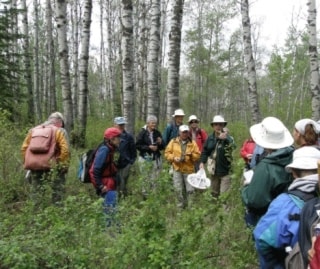Review staff
A recent expedition into a Rimbey-area nature preserve proved to be an informative and educational experience for a group of conservation volunteers and researchers who were involved in a bird and plant species count.
Volunteers from the Canadian Forest Service, Rangeland Conservation Service, and Red Deer River Naturalists gathered on the 160-acre Spirit Rocks Nature Sanctuary on May 30 to conduct the survey.
Described as an island of natural habitat amidst an expansive agricultural region, the sanctuary contains a diversity of plant communities including Plains Rough Fescue grasslands and White Spruce forests, as well as stream-fed riparian areas that are important to many native bird and plant species.
“Because of its isolation and diversity of wildlife, these properties are important to retain as natural habitat,” said Tina Sun of the Nature Conservancy of Canada (NCC). “This event was an opportunity for local residents to become directly involved in the conservation of Canada’s natural biodiversity by gathering wildlife data critical for NCC’s conservation planning and to supplement Red Deer River Naturalists’ May species count.”
In addition to conducting the count of birds and plants, those who participated in the survey were also exposed to the importance of the preservation of wetlands and wilderness areas.
“Wetlands and wild areas are vital to the survival of all kind of species, many of which will become endangered if the habitat they rely upon for food and cover continues to shrink,” Sun said. “Preservation of wild areas is not only critical for the survival of these species, but also for our knowledge and enjoyment of the natural world...not to mention for human health.”
She was quick to add that without the help of like-minded individuals such as Joanne Susut of Rimbey who donated the sanctuary to the NCC in 1996, the study may not have been possible.
“Conservation-minded landowners like Joanne are highly important for the preservation of our native Albertan landscapes, and for the work of our organization,” Sun said. “The NCC relies on private landowners who take an interest in the protection of biodiversity, and Joanne has been working with us for many years to ensure her land is conserved in perpetuity. A conservation easement is one of the most effective ways a landowner can protect their property over the long term. And the landowner can remain involved with the management of their land in partnership with the land trust who holds their easement.”
Because of the delicate nature of the study and the sanctuary, the location of the land is being withheld in order to protect and preserve the bio-system however if any landowner in the area is interested in continuing the legacy, they are encouraged to contact Tina Sun at the Nature Conservancy of Canada - Alberta Region at 403-200-6825.
